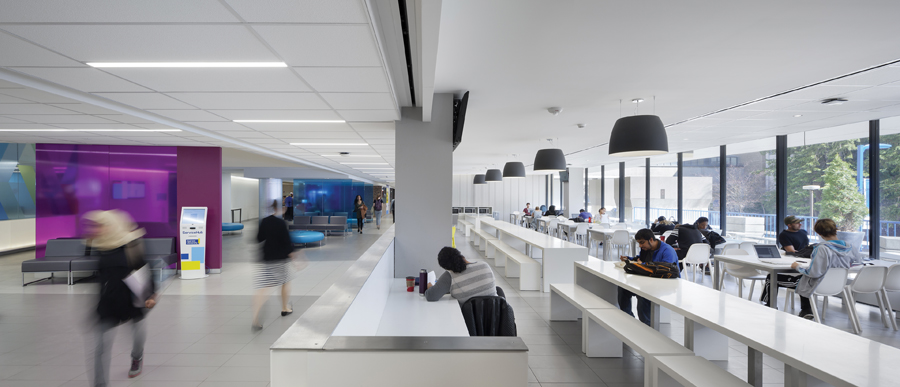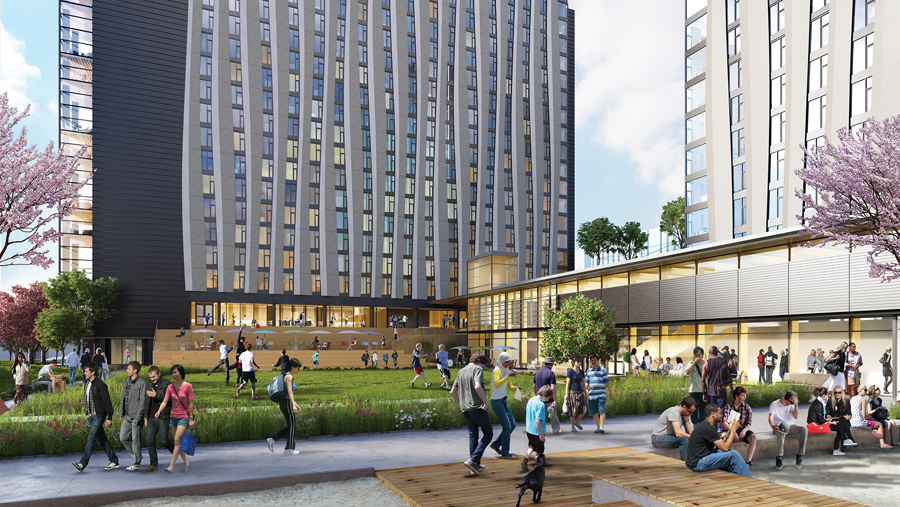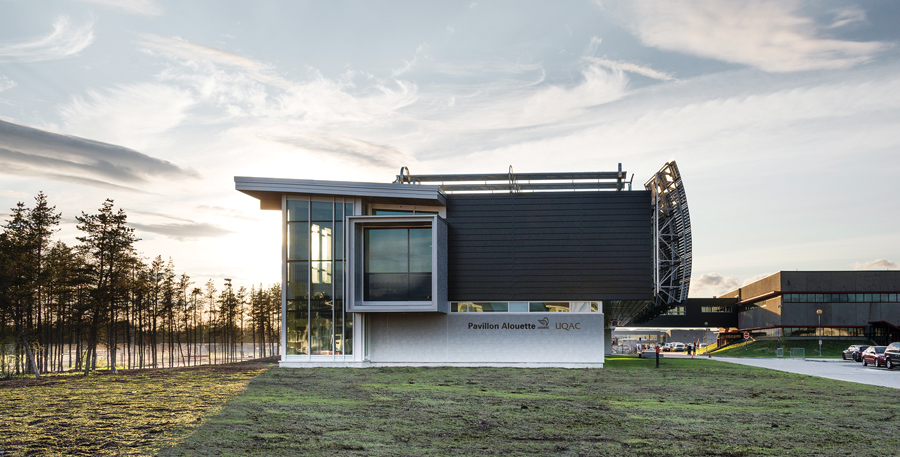Aiming Higher: Ryerson Service Hub, Orchard Commons, University College of the North, Alouette UQAC University Building
Grade school enrolment has entered a sharp demographic dip in many parts of Canada, which means that post-secondary institutions will soon be vying for a dwindling number of students. Perhaps it’s no coincidence that, as the competition for the best college and university students intensifies, the architecture of higher education is getting smarter—and finding new ways to put students first.
In the past two decades, educational pedagogy has increasingly moved towards what is known as student-centred learning: a shift away from the traditional classroom with a teacher spouting information, toward interactive methods that emphasize learning by doing, often in groups.
Now, higher-education buildings are expanding the definition of what it means to be “student-centred.” In Toronto, Ryerson University’s ServiceHub consolidates student services into a sleek, gleaming antidote to lineups; at the University of British Columbia in Vancouver, Orchard Commons is an all-in-one residence and academic centre specifically designed for international students and frosh. And in the far reaches of Quebec and Manitoba, Alouette University and University College of the North respond directly to challenges that have previously hindered higher education from taking root in remote communities.
Ryerson Service Hub
Toronto, Ontario
Gow Hastings Architects

In the bad old days of student services at Ryerson University, paying fees or changing courses generally involved queuing to complete a transaction at one counter within Jorgenson Hall’s dark corridors, and then being told to line up all over again somewhere else within the block-long Brutalist building. “Services that were connected in students’ minds were all separate in our organizational structure,” explains Heather Lane Vetere, Vice Provost of Students at Ryerson University.
Most of Jorgenson Hall is still a textbook example of 1970s academic architecture at its double-loaded-corridor dreariest, but the 1,200- square-metre portion of it recently transformed into Ryerson’s ServiceHub is now thoroughly 21st century. “What we envisioned,” says Vetere, “was a one-stop shop; a place where students could eat, talk to their friends, do schoolwork, or at least sit down while they waited.”
“This was a whole new model for Ryerson, not only in terms of space, but operationally,” says Valerie Gow, FRAIC, of Gow Hastings Architects. Her firm, with project architect Allan Banina, worked in close consultation with the Ryerson project management team that engineered the organizational retooling. The resulting space functions something like a technologically advanced hospital admissions department, but looks more like an Apple Store, with lots of backlit white Corian and upbeat pops of colour.
The ServiceHub’s integrated, boldly scaled environmental graphics were part of Gow Hastings’ scope of work. Near the entry, an extra-large information symbol marks the check-in point. At this “triage” counter, students explain the purpose of their visit to staff. For straightforward bits of administration, they proceed to a touchdown self-service counter and complete the task on one of the computer screens set into a mirrored glass wall. Those with more involved transactions receive an alphanumeric ticket.
While waiting for their code to appear on a monitor, students can take a seat in the double-height lounge or in a sunny study area near the cafeteria. Plug-in points for recharging electronic devices are plentiful. If the wait time will be more than a few minutes, ServiceHub staff will text them when they’re third in line.
Along the east side of the ServiceHub, students glimpse their destination—either a staffed service station on an open-plan floor, or, for more personal or complex matters, a line of private offices along the perimeter. Diagonal bands of translucent film in the yellow and blue of Ryerson’s brand identity have been strategically applied to the glass wall between the waiting and service zones. “You can see where you’re going to go, and yet privacy is maintained,” says design director Jim Burkitt.
The ServiceHub opened last fall, and at the busiest times of the year, as many as 500 students descend upon it at once. “But we don’t get ‘I’m waiting too long’ complaints anymore,” says Kevin Goodchild, Assistant Director of Client Relations in Ryerson’s Office of the Registrar. “This has really transformed our service.”
Orchard Commons, University of British Columbia
Vancouver, British Columbia
Perkins + Will

On its Point Grey campus in Vancouver, the University of British Columbia is building five mixed-use hubs that integrate student residences with academic space. Orchard Commons—the second and most recently completed of them—will accommodate some 1,048 first-year international and domestic students. Synergistically, it also houses the classrooms and faculty offices of Vantage College, UBC’s transitional program for first-year international students not yet fully fluent in English.
Organized into two perpendicular towers, the site planning of Orchard Commons preserves a key pedestrian circulation route on the campus. A widened stair doubles as seating, negotiating a grade change at the base of one of the towers while providing south-facing views across a lawn that is bound to see a lot of hacky sack and Frisbee action.
Most of the residents of Orchard Commons will be 17-to-19-year-olds, living away from home for the first time. While highrises aren’t an intuitive choice for frosh, “development pressures on the campus have made towers necessary,” says Perkins+Will senior associate Derek Newby, MRAIC. Finding ways to foster a sense of community and encourage social interaction—especially for students needing to overcome a language barrier—was central to the design team’s approach.
Perkins+Will’s most notable response to this challenge is to make common spaces visible. Research conducted by the university determined that 100 people is the ideal size for a “house” within a campus residence—large enough for variety, small enough for everyone to know each other. That’s the approximate occupancy of three floors in each tower. So the designers positioned glazed, three-storey lounges at one end of each building, providing shared social spaces for the students residing in each triple-floor cluster. An exit stair looks onto these stacked lounges, giving students glimpses at what’s going on throughout the building.
Wood is used purposefully to mark gathering spaces such as the lounges, dining hall, and Vantage College’s common areas. Although precast concrete is not inherently the warmest of materials, using it in combination with computational modeling made it possible to soften the tower façades with organic curves, without blowing the budget. Only 18 different storey-high, modular precast forms were needed to fabricate the flowing patterns, and Grasshopper software was used to achieve the
desired 60-40 solid-to-glass ratio on this LEED Gold-targeted project.
University College of the North
Thompson, Manitoba
Architecture49

Situated nearly 500 miles north of Winnipeg, the town of Thompson, Manitoba, was founded in 1957 by the provincial government with mining company Inco. The community’s population reached a high of approximately 26,000 in the 1970s, but is now closer to 13,000. More than a third of its residents are First Nations or Métis.
Designed by Architecture49 (formerly Smith Carter), the first purpose-built campus of University College of the North (UCN) opened in Thompson in 2014. UCN—which also has a campus in Le Pas, Manitoba, along with a dozen satellite locations—offers a mix of trade, adult education, certificate, diploma and university degree-granting programs.
To make the institution viable in a community of this size, the UCN Thompson Campus shares a site and a number of facilities with the Thompson Regional Community Centre, constructed a few years earlier. UCN students use the centre’s gymnasium, while the community centre shares UCN’s daycare and food services area.
Doug Corbett, MRAIC, who led Architecture49 on the campus design (he subsequently left to found Corbett Architecture), says that local factors—from student demographics to available construction resources—shaped the project. “The average age of UCN students is 27, and most are single parents,” says Corbett. “Access to education for them is totally dependent on having childcare and having housing, and it’s important to them to be close to their extended family.”
Occupying what was once a parking lot surfaced with mine waste backfill, the 8,155-square-metre building arcs gently around a landscaped, south-facing public space that Corbett describes as Thompson’s “piazza.” To the west, an accessible green roof ramps up and over the daycare and connects to the main four-storey volume.
In a region where transporting materials is expensive and specialized construction labour is scarce, Architecture49 used what was locally available wherever possible, and selected materials that required little or no finishing. Granite from a nearby quarry clads the ground level and fills the Gabion cages—constructed by non-skilled local labourers—that frame the ramp and enclose the daycare’s play area. Cedar panels, unfinished steel siding and exposed concrete floors were used extensively on this LEED Gold project, which incorporates operable windows on the south side and a cost-efficient dual fuel (electricity and gas) heating system.
One of the top priorities was to create an educational facility that would be welcoming to the entire community. At the main entrance, carved panels by local artist Irvin Head symbolize education as a journey. The building is organized along a linear atrium that acts as a “main street” connecting to the community centre. With its food services area, the atrium has already become a popular local destination, attracting everyone from students at the neighbouring high school on their lunch hour, to parents of children playing hockey at the community centre.
But the educational journeys that UCN offers are still new options for Thompson, and many of its residents have hesitated to embark on them. “We built it for an enrolment of approximately 1,200, and we’re still sitting at around 300 to 400,” says Corbett. “But it’s only been a couple of years. It’s a generational thing that has to happen, and it’s not going to happen overnight.”
Alouette-UQAC University Building
Sept-Îles, Quebec
BGLA Architecture + Design Urbain

The fortunes of Sept-Îles, Quebec, and Aluminerie Alouette are closely interconnected. In 1989, the company—now the largest aluminum smelter in the Americas—established its first facility in the northeastern region of the province. The area encompasses a mainland community of 26,000 and a sparsely populated scattering of St. Lawrence River islands.
Aluminerie Alouette has more than doubled its Sept-Îles base of operation since then, and continues to expand—due in part to a quid pro quo accord struck between the Province of Quebec and the region’s largest employer in 2011. The smelter agreed to construct a $10-million university building in Sept-Îles, in exchange for access to additional electricity from the province to increase its aluminum production.
Previously, the Université du Québec à Chicoutimi (UQAC) offered an adult education program at the Cégep de Sept-Îles—part of the province-wide junior college network. The new 3,200-square-metre Alouette-UQAC university building, which opened at the end of 2014, significantly expands local access to higher education. Adjacent the Cégep and designed to accommodate 400 students, it is already nearing capacity.
The three-storey university building was designed by BGLA Architecture + Design Urbain, which has a satellite office in Sept-Îles in addition to its Quebec City and Montreal studios. The design team conceived Alouette-UQAC as an educational facility that would showcase aluminum’s many uses in construction, including in sustainable technologies, while also drawing parallels between the processes of refining aluminum and gaining knowledge.
That analogy runs through the building from its north façade to its south-facing atrium. The perforated, convex aluminum panels that screen the north side from a public plaza represent “raw knowledge.” The inner wall of the atrium is the “knowledge filter”—a porous surface of foamed aluminum, manufactured in Ontario by Cymat Technologies from recycled cans. Along the glazed south side, the triple-height atrium, designed for use by university and Cégep students as well as the community at large, is the “knowledge crossroads,” a place for sharing what has been learned.
Other elements throughout Alouette-UQAC are also constructed from aluminum, ranging from the feature stair’s structural frame and railings, to the modular wall system that allows faculty and administrative offices to be reconfigured to meet future needs.
To BGLA’s Pierre André Lévesque, MIRAC, it was important for Sept-Îles’ first university building to employ advanced sustainability techniques, demonstrating how greater knowledge can lead to greater good. Key green design attributes include glulam timber and CLT panel construction, and a solar wall that preheats fresh air before it enters the ventilation system.
But the most compelling sustainability story involves the innovative solar collectors on the roof, manufactured by Rackam of Sherbrooke, Quebec, and making their institutional project debut at Alouette-UQAC. Installation of the geothermal system integral to the building’s hybrid technology loop is not yet complete, but when it is up and running, the combination of the collectors and an ejector-compression cooling system will not only harness the sun’s heat to warm the building
in the colder months, but also use it for cooling in the warmer months. And of course, the collectors are made of aluminum.
Pamela Young is a Toronto-based writer, editor and communications manager.























